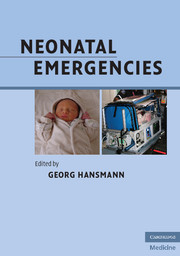Book contents
- Frontmatter
- Contents
- List of contributors
- Foreword (1)
- Foreword (2)
- Preface
- Acknowledgments
- Section 1 Organization of neonatal transport
- Section 2 Basics in cardiopulmonary resuscitation of newborn infants
- Section 3 Classic and rare scenarios in the neonatal period
- Section 4 Transport
- Section 5 Appendix
- Training NICU nurses and paramedics in the neonatal emergency transport service (NETS)
- Training delivery room staff in the resuscitation of newborn infants
- Web links: societies, hospitals, guidelines and learning programs
- Growth charts
- Bilirubin diagrams and transfusion exchange limits
- Aortic blood pressure during the first 12h of life in infants with birth weight 610–4220 g
- Laboratory: normal values
- Unit conversions
- References (Section 5)
- Index
- Plate section
Training delivery room staff in the resuscitation of newborn infants
from Section 5 - Appendix
Published online by Cambridge University Press: 05 March 2012
- Frontmatter
- Contents
- List of contributors
- Foreword (1)
- Foreword (2)
- Preface
- Acknowledgments
- Section 1 Organization of neonatal transport
- Section 2 Basics in cardiopulmonary resuscitation of newborn infants
- Section 3 Classic and rare scenarios in the neonatal period
- Section 4 Transport
- Section 5 Appendix
- Training NICU nurses and paramedics in the neonatal emergency transport service (NETS)
- Training delivery room staff in the resuscitation of newborn infants
- Web links: societies, hospitals, guidelines and learning programs
- Growth charts
- Bilirubin diagrams and transfusion exchange limits
- Aortic blood pressure during the first 12h of life in infants with birth weight 610–4220 g
- Laboratory: normal values
- Unit conversions
- References (Section 5)
- Index
- Plate section
Summary
Resuscitating babies at birth, like resuscitation at other times of life, requires both theoretical knowledge and practical skills. Perhaps the most effective introduction to these is gained by attendance at a practical course designed for the purpose, ideally followed by a period of well supervised in-service training. Two such courses are currently in widespread use. The Newborn Life Support course, developed by the Resuscitation Council (UK) and endorsed by all relevant UK professional bodies, has been available in the UK since 1999 and has more recently become available in other countries in Europe under the auspices of the European Resuscitation Council. In the USA the Neonatal Resuscitation Program, first developed by the American Academy of Pediatrics in 1985, is very widely used and has spread to other countries. Members of the committees controlling the development of each of these courses also work together as members of the neonatal section of the International Liaison Committee on Resuscitation (ILCOR), thus ensuring that a reasonably consistent approach is adopted by both courses. Whatever system is adopted for training doctors and other delivery room staff, it is important that those involved in teaching should themselves have not only significant practical experience of newborn resuscitation but also appropriate skills in teaching.
Theoretical knowledge
An understanding of the physiology of birth asphyxia (as outlined in the chapter on resuscitation of newborns at birth, p. 150) leads logically to the familiar ABCD approach (Airway, Breathing, Circulation, Drugs), which can be readily adapted to this situation.
- Type
- Chapter
- Information
- Neonatal Emergencies , pp. 511 - 512Publisher: Cambridge University PressPrint publication year: 2009



